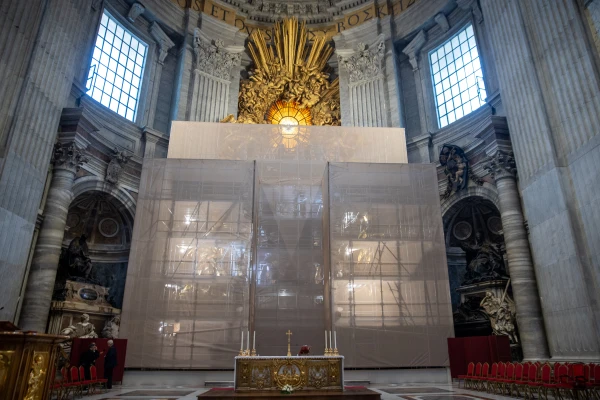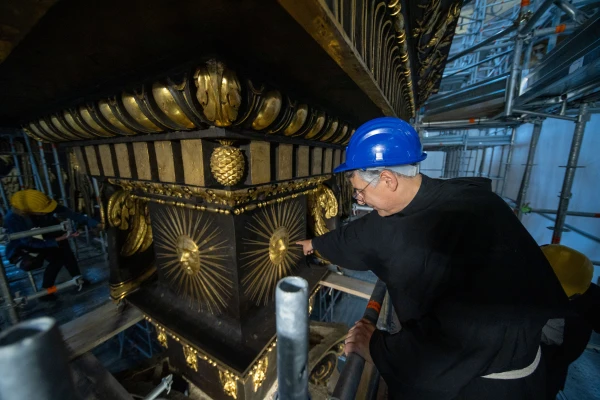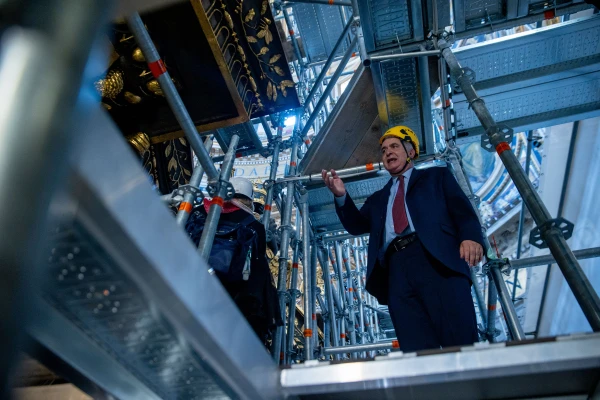The completed restorations of the bronze baldachin above the central altar of St. Peter’s Basilica, designed by Gian Lorenzo Bernini, will be inaugurated at the end of the month.
The baldachin is one of the most emblematic works of the basilica and is being restored for the first time since 1758. It will be shown to the public again on October 27, coinciding with the closing of the Synod of Bishops and the World Day of Peace. This restoration is being carried out in preparation for the Jubilee of Hope, which will attract millions of pilgrims to Rome in 2025.
Receive the main news from ACI Prensa by WhatsApp and Telegram
It is increasingly difficult to see Catholic news on social media. Subscribe to our free channels today:
According to Father Enzo Fortunato, communications director of St. Peter’s Basilica, the goal is for those who visit the basilica to be able to experience the beauty and perfection of the work of art in all its splendor.
“So that the pilgrims who come to the Jubilee can enjoy this explosion of color, this explosion of perfection, the joy that the monuments truly transmit,” Father Fortunato told EWTN News.
The restoration also has a deeper meaning for the Church. Cardinal Mauro Gambetti, archpriest of St. Peter’s Basilica and coordinator of the works, expressed his hope that this Jubilee Year will promote positive change in the world.

“The hope, I would say, is that something happens during the jubilee, that something happens that can touch hearts and thus open a vision, a horizon that can direct the history of humanity in a different direction,” said the cardinal in the interview.
The work, which weighs more than 60 tons and reaches 30 meters high, is a central symbol in the basilica. The restoration has been made possible thanks to the generous donation of the Knights of Columbus, who contributed more than $750,000 to the project.
According to one of the restorers of the San Pedro Factory, the main intervention in the work was the cleaning of the gold leaf that covers the bronze structure, allowing its original brilliance to shine once again.
“Dust, the accumulation of cleaning materials and humidity had created a layer on the gold, preventing its shine from being appreciated,” explained the restorer. Furthermore, the location of the baldachin, which took Bernini nine years, is of crucial symbolic importance, situated just above the tomb of the apostle Saint Peter.

According to Giorgio Capriotti, another restaurateur involved in the project, “the location is not coincidental, the place is absolutely crucial.” “We are in the center of the zenith, the vertical line that unifies the top of the dome and the tomb of Saint Peter, so we are on exactly the same vertical line. “They were absolutely aware of the symbolic function of this position,” he said.
The baldachin, which was commissioned from Bernini by Pope Urban VIII in 1624, is not only a Baroque masterpiece, but also a fundamental piece in the structure and spirituality of St. Peter’s Basilica. Below him, in the crypt, rest the remains of almost 150 pontiffs, which adds even more historical and spiritual weight to this monument.

The public will be able to see the grand canopy’s 400-year-old bronze columns for the first time since the restoration when Pope Francis presides at the closing Mass of the Synod on Synodality on October 27.
At that time the scaffolding that has surrounded the central altar for eight months will be permanently removed.

